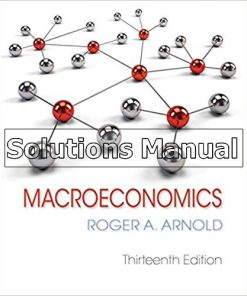Macroeconomics 12th Edition Arnold Test Bank
You may also like
-
$26.50
$50.00 -
$26.50
$50.00 -
$26.50
$50.00 -
$26.50
$50.00
This is completed downloadable of Macroeconomics 12th Edition Arnold Test Bank

Product Details:
- ISBN-10 : 1285738314
- ISBN-13 : 978-1285738314
- Author: Roger A. Arnold
Ever wonder why you have the number of friends that you do? Would a tax on soda really reduce obesity? What is going on with the financial problems in Greece? Is a tax rebate is better than a tax bonus? MACROECONOMICS, 12E answers these questions and many more as this book opens up the world of economic analysis. This edition offers more detailed coverage of the financial and economic crisis than any other macroeconomics book of its kind on the market. Memorable examples from pop culture illustrate the unexpected places macroeconomics occur and show how economic forces link to every day events. This edition offers complete video assets ideal for self-study. “Video Office Hours” digital lectures walk you through worked problems, while brief “Working with Diagrams” videos demonstrate key concepts in graphing that you can play and replay. A new Adaptive Test Prep Tool available on MindTap enables you to assess your personal economic understanding. Powerful digital resources, including Aplia, MindTap work with the book’s latest content to reflect today’s changing economy and equip you with a thorough understanding of contemporary macroeconomics.
Table of Content:
- Ch 1: What Economics Is About
- Ch 1: Introduction
- 1-1: Your Life, 2016–2026
- 1-2: A Definition of Economics
- 1-3: Key Concepts in Economics
- 1-4: The Market and Government
- 1-5: Ceteris Paribus and Theory
- 1-6: Economic Categories
- Ch 1: Chapter Summary
- Ch 1: Key Terms and Concepts
- Ch 1: Video Questions and Problems
- Ch 1: Questions and Problems
- Ch 1: Working with Numbers and Graphs
- Appendix A: Working with Diagrams
- Appendix B: Should You Major in Economics?
- Ch 2: Production Possibilities Frontier Framework
- Ch 2: Introduction
- 2-1: The Production Possibilities Frontier
- 2-2: Specialization and Trade Can Move Us Beyond Our PPF
- Ch 2: Chapter Summary
- Ch 2: Key Terms and Concepts
- Ch 2: Video Questions and Problems
- Ch 2: Questions and Problems
- Ch 2: Working with Numbers and Graphs
- Ch 3: Supply and Demand: Theory
- Ch 3: Introduction
- 3-1: What Is Demand?
- 3-2: Supply
- 3-3: The Market: Putting Supply and Demand Together
- Ch 3: Chapter Summary
- Ch 3: Key Terms and Concepts
- Ch 3: Video Questions and Problems
- Ch 3: Questions and Problems
- Ch 3: Working with Numbers and Graphs
- Ch 4: Prices: Free, Controlled, and Relative
- Ch 4: Introduction
- 4-1: Price
- 4-2: Price Controls
- 4-3: Two Prices: Absolute and Relative
- Ch 4: Chapter Summary
- Ch 4: Key Terms and Concepts
- Ch 4: Video Questions and Problems
- Ch 4: Questions and Problems
- Ch 4: Working with Numbers and Graphs
- Ch 5: Supply, Demand, and Price: Applications
- Ch 5: Introduction
- 5-1: Application 1: Tickets to The Big Bang Theory
- 5-2: Application 2: Easier-to-obtain Loans and Higher Housing Prices
- 5-3: Application 3: The Price of an Aisle Seat
- 5-4: Application 4: What Will Happen to the Price of Marijuana if the Purchase and Sale of Marijuana
- 5-5: Application 5: Speculators, Price Variability, and Patterns
- 5-6: Application 6: Why Is Medical Care So Expensive?
- 5-7: Application 7: Why Do Colleges Use GPAs, ACTs, and SATs for Purposes of Admission?
- 5-8: Application 8: Supply and Demand on a Freeway
- 5-9: Application 9: Are Renters Better Off?
- 5-10: Application 10: Do You Pay for Good Weather?
- 5-11: Application 11: College Superathletes
- 5-12: Application 12: 10 a.m. Classes in College
- 5-13: Application 13: Salsa, Chips, and Beer
- Ch 5: Chapter Summary
- Ch 5: Video Questions and Problems
- Ch 5: Questions and Problems
- Ch 5: Working with Numbers and Graphs
- Ch 6: Macroeconomic Measurements, Part I: Prices and Unemployment
- Ch 6: Introduction
- 6-1: Measuring the Price Level
- 6-2: Measuring Unemployment
- Ch 6: Chapter Summary
- Ch 6: Key Terms and Concepts
- Ch 6: Video Questions and Problems
- Ch 6: Questions and Problems
- Ch 6: Working with Numbers and Graphs
- Ch 7: Macroeconomic Measurements, Part II: GDP and Real GDP
- Ch 7: Introduction
- 7-1: Gross Domestic Product
- 7-2: The Expenditure Approach to Computing GDP for a Real-World Economy
- 7-3: The Income Approach to Computing GDP for a Real-World Economy
- 7-4: Real GDP
- Ch 7: Chapter Summary
- Ch 7: Key Terms and Concepts
- Ch 7: Video Questions and Problems
- Ch 7: Questions and Problems
- Ch 7: Working with Numbers and Graphs
- Ch 8: Aggregate Demand and Aggregate Supply
- Ch 8: Introduction
- 8-1: A Way to View the Economy
- 8-2: Aggregate Demand
- 8-3: Short-Run Aggregate Supply
- 8-4: Putting AD and SRAS Together: Short-Run Equilibrium
- 8-5: Long-Run Aggregate Supply
- Ch 8: Chapter Summary
- Ch 8: Key Terms and Concepts
- Ch 8: Video Questions and Problems
- Ch 8: Questions and Problems
- Ch 8: Working with Numbers and Graphs
- Ch 9: Classical Macroeconomics and the Self-Regulating Economy
- Ch 9: Introduction
- 9-1: The Classical View
- 9-2: Three States of the Economy
- 9-3: The Self-Regulating Economy
- Ch 9: Chapter Summary
- Ch 9: Key Terms and Concepts
- Ch 9: Video Questions and Problems
- Ch 9: Questions and Problems
- Ch 9: Working with Numbers and Graphs
- Ch 10: Keynesian Macroeconomics and Economic Instability: A Critique of the Self-Regulating Economy
- Ch 10: Introduction
- 10-1: Questioning the Classical Position and the Self-Regulating Economy
- 10-2: The Simple Keynesian Model
- 10:3: The Simple Keynesian Model in the AD-AS Framework
- 10:4: The Simple Keynesian Model in the TE-TP Framework
- Ch 10: Chapter Summary
- Ch 10: Key Terms and Concepts
- Ch 10: Video Questions and Problems
- Ch 10: Questions and Problems
- Ch 10: Working with Numbers and Graphs
- Ch 11: Fiscal Policy and the Federal Budget
- Ch 11: Introduction
- 11-1: The Federal Budget
- 11-2: Fiscal Policy
- 11-3: Demand-Side Fiscal Policy
- 11-4: Supply-Side Fiscal Policy
- Ch 11: Chapter Summary
- Ch 11: Key Terms and Concepts
- Ch 11: Video Questions and Problems
- Ch 11: Questions and Problems
- Ch 11: Working with Numbers and Graphs
- Ch 12: Money, Banking, and the Financial System
- Ch 12: Introduction
- 12-1: Money: What Is It and How Did It Come to Be?
- 12-2: Defining the Money Supply
- 12-3: How Banking Developed
- 12-4: The Financial System
- Ch 12: Chapter Summary
- Ch 12: Key Terms and Concepts
- Ch 12: Video Questions and Problems
- Ch 12: Questions and Problems
- Ch 12: Working with Numbers and Graphs
- Ch 13: The Federal Reserve System
- Ch 13: Introduction
- 13-1: The Structure and Functions of the Federal Reserve System (the Fed)
- 13-2: The Money Supply Expansion Process
- 13-3: Other Fed Tools and Recent Fed Actions
- Ch 13: Chapter Summary
- Ch 13: Key Terms and Concepts
- Ch 13: Video Questions and Problems
- Ch 13: Questions and Problems
- Ch 13: Working with Numbers and Graphs
- Appendix C: The Market for Reserves (or The Federal Funds Market)
- Ch 14: Money and the Economy
- Ch 14: Introduction
- 14-1: Money and the Price Level
- 14-2: Monetarism
- 14-3: Inflation
- 14-4: Money and Interest Rates
- Ch 14: Chapter Summary
- Ch 14: Key Terms and Concepts
- Ch 14: Video Questions and Problems
- Ch 14: Questions and Problems
- Ch 14: Working with Numbers and Graphs
- Ch 15: Monetary Policy
- Ch 15: Introduction
- 15-1: Transmission Mechanisms
- 15-2: Monetary Policy and the Problem of Inflationary and Recessionary Gaps
- 15-3: Monetary Policy and the Activist–Nonactivist Debate
- 15-4: Nonactivist Monetary Proposals
- Ch 15: Chapter Summary
- Ch 15: Key Terms and Concepts
- Ch 15: Video Questions and Problems
- Ch 15: Questions and Problems
- Ch 15: Working with Numbers and Graphs
- Appendix D: Bond Prices and the Interest Rate
- Ch 16: Expectations Theory and the Economy
- Ch 16: Introduction
- 16-1: Phillips Curve Analysis
- 16-2: The Controversy Begins: Are There Really Two Phillips Curves?
- 16-3: Rational Expectations and New Classical Theory
- 16-4: New Keynesians and Rational Expectations
- 16-5: Looking at Things from the Supply Side: Real Business Cycle Theorists
- Ch 16: Chapter Summary
- Ch 16: Key Terms and Concepts
- Ch 16: Video Questions and Problems
- Ch 16: Questions and Problems
- Ch 16: Working with Numbers and Graphs
- Ch 17: Economic Growth: Resources, Technology, Ideas, and Institutions
- Ch 17: Introduction
- 17-1: A Few Basics About Economic Growth
- 17-2: A Production Function and Economic Growth
- Ch 17: Chapter Summary
- Ch 17: Key Terms and Concepts
- Ch 17: Video Questions and Problems
- Ch 17: Questions and Problems
- Ch 17: Working with Numbers and Graphs
- Ch 18: The Financial Crisis of 2007–2009
- Ch 18: Introduction
- 18-1: The Financial and Real Sectors of the Economy
- 18-2: The Financial Crisis as a Balance Sheet Problem
- 18-3: The Fed, Interest Rates, and Housing Prices
- 18-4: The Taylor Rule and Interest Rates
- 18-5: The Politics of Housing
- 18-6: Fannie Mae and Freddie Mac
- 18-7: The Role of Leverage and Regulatory Capital Arbitrage
- Ch 18: Chapter Summary
- Ch 18: Key Terms and Concepts
- Ch 18: Video Questions and Problems
- Ch 18: Questions and Problems
- Ch 18: Working with Numbers and Graphs
- Ch 19: Debates in Macroeconomics Over the Role and Effects of Government
- Ch 19: Introduction
- 19-1: Macroeconomics and Government: The Debate
- 19-2: Tax Cuts, Tax Revenue, and Budget Deficits
- 19-3: The Economy: Self-Regulating or Not?
- 19-4: More Government Spending or a Cut in Taxes: Which Gives a Bigger Bang for the Buck?
- 19-5: More Government Spending or a Cut in Taxes: The Size and Scope of Government
- 19-6: The Degree of Crowding Out
- 19-7: The Politics of Government Spending
- 19-8: Monetary Policy: Rules Versus Discretion
- 19-9: Bailouts
- 19-10: Demand-Side and Supply-Side Views of the Economy and Government Tools for Changing Real GDP
- Ch 19: Chapter Summary
- Ch 19: Key Terms and Concepts
- Ch 19: Video Questions and Problems
- Ch 19: Questions and Problems
- Ch 19: Working with Numbers and Graphs
- Ch 20: Public Choice and Special-Interest Group Politics
- Ch 20: Introduction
- 20-1: Public Choice Theory
- 20-2: The Political Market
- 20-3: Voters and Rational Ignorance
- 20-4: More About Voting
- 20-5: Special-Interest Groups
- 20-6: Constitutional Economics
- Ch 20: Chapter Summary
- Ch 20: Key Terms and Concepts
- Ch 20: Video Questions and Problems
- Ch 20: Questions and Problems
- Ch 20: Working with Numbers and Graphs
- Ch 21: Building Theories to Explain Everyday Life: From Observations to Questions to Theories to Pre
- Ch 21: Introduction
- 21-1: A Different Kind of Chapter
- 21-2: The Process
- 21-3: Observation/Thought 1: The Birthrates in Various Countries Are Different
- 21-4: Observation/Thought 2: The Ethical Code of People Who Live in a Small Town Is Different From T
- 21-5: Observation/Thought 3: The Closer the Dollar Tuition the Student Pays Is to the Equilibrium Tu
- 21-6: Observation/Thought 4: Criminals Are Not Rational
- 21-7: Observation/Thought 5: More Students Wear Baseball Caps in Class on Exam Days Than on Other Da
- 21-8: Observation/Thought 6: Houses in “Good” School Districts Are Often More Expensive Than Com
- 21-9: Observation/Thought 7: Are People Better Off With or Without Health Care Vouchers?
- 21-10: Observation/Thought 8: People Who Give to Others Often Complain That They End Up Giving Too M
- Ch 21: Chapter Summary
- Ch 21: Video Questions and Problems
- Ch 21: Questions and Problems
- Ch 21: Working with Numbers and Graphs
- Ch 22: International Trade
- Ch 22: Introduction
- 22-1: International Trade Theory
- 22-2: Trade Restrictions
- Ch 22: Chapter Summary
- Ch 22: Key Terms and Concepts
- Ch 22: Video Questions and Problems
- Ch 22: Questions and Problems
- Ch 22: Working with Numbers and Graphs
- Ch 23: International Finance
- Ch 23: Introduction
- 23-1: The Foreign Exchange Market
- 23-2: Flexible Exchange Rates
- 23-3: Fixed Exchange Rates
- 23-4: Fixed Exchange Rates Versus Flexible Exchange Rates
- Ch 23: Chapter Summary
- Ch 23: Key Terms and Concepts
- Ch 23: Video Questions and Problems
- Ch 23: Questions and Problems
- Ch 23: Working with Numbers and Graphs
- Ch 24: Globalization and International Impacts on the Economy
- Ch 24: Introduction
- 24-1: What Is Globalization?
- 24-2: Two Ways to See Globalization
- 24-3: Globalization Facts
- 24-4: The Movement Toward Globalization
- 24-5: Benefits and Costs of Globalization
- 24-6: The Continuing Globalization Debate
- 24-7: Less Globalization or More: A Tug-of-War?
- 24-8: International Factors and Aggregate Demand
- 24-9: International Factors and Aggregate Supply
- 24-10: Factors That Affect Both Aggregate Demand and Aggregate Supply
- 24-11: Deficits: International Effects and Domestic Feedback
- Ch 24: Chapter Summary
- Ch 24: Key Terms and Concepts
- Ch 24: Video Questions and Problems
- Ch 24: Questions and Problems
- Ch 24: Working with Numbers and Graphs
- Self-Test Appendix
- Glossary
- Index
- IBC
People Also Search:
macroeconomics arnold
macroeconomics 12th edition arnold
macroeconomics 12th edition
macroeconomics 12th edition testbank download pdf
macroeconomics 12th edition download scribd












